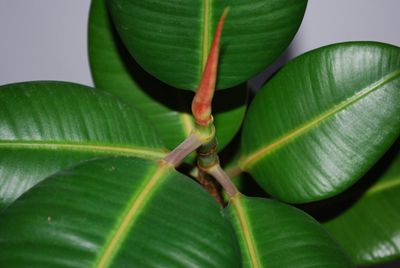How Much Water Do Rubber Tree Plants Need?
Ficus are a large genus of tropical to semi-tropical plants, many of which are perfect for the home interior. The rubber plant produces a perfect home sized tree and is adaptable to indoor growing. Water requirements for rubber plants are consistently moist but never soggy. Soggy plants can get root rot, soil gnats and other problems. Dry soil causes leaves to drop and reduces the overall health and growth of the plant. Getting rubber plant watering right will ensure beautiful leaves and maximum growth. Rubber plants are rainforest specimens. As such, they are adapted to plentiful water. But as with most plants, excess or standing water can be detrimental to their health. So how much water do rubber tree plants need? The first step is to ensure the container the plant is in has adequate drainage holes. Also, make sure the potting medium has some peat, vermiculite or perlite in it. Peat holds water and air, increasing porosity. Vermiculite has the same purpose while a calcined clay perlite improves moisture and nutrient holding abilities of the soil medium. Use a dish under the plant that is lined with pebbles to catch excess moisture but keep the roots from sitting in water. This will evaporate gradually increasing humidity around the rubber tree. Never allow a container to sit in a saucer or dish without rocks. Roots sitting in soggy soil will deteriorate and the plant will suffer.
When to Water a Rubber Tree Plant
The obvious answer is when the plant is dry but there is more to it than that. Even indoor plants respond to light and temperature changes. In winter, plants get less daylight and feel cold. They go into a sort of hibernation until more sunlight is available. Therefore, during winter you can cut watering in half. However, plants that are positioned near a fireplace or furnace will have their potting soil dry out much more quickly. In any case, if the top few inches of soil are dry, it is time to water. You may opt for a water meter or simply insert your finger into soil. Most water meters should read a 4 at optimum moisture levels. Rubber plants need to be checked weekly during the growing season. A good sign that you are overwatering is yellow leaves. At the first sign of yellowing, decrease watering slightly and healthy green, glossy leaves should appear. Prior to watering, allow tap water to sit for a few hours to allow chlorine to evaporate and the water to come to room temperature. This causes less shock to the plant than icy water. When watering a rubber plant, drench the soil completely until excess moisture runs out the drainage holes. This will not only water the roots but leach out any built-up salts from fertilizing. Allow the top few inches of soil to dry out between each watering.
